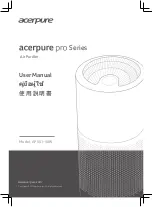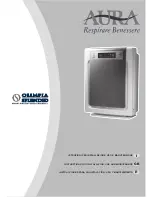
34
9-4. TROUBLESHOOTING BY INFERIOR PHENOMENA
Note: Refer to the manual of outdoor unit for the detail of remote
controller.
(3)Upward/downward vane
performance failure
1
The vane is not downward during defrosting and
heat preparation and when the thermostat is OFF in
HEAT mode. (Working of COOL protection function)
2
Vane motor does not rotate.
• Defective vane motor
• Breaking of wire or connection failure of connector
3
Upward/downward vane does not work.
• The vane is set to fixed position.
1
Normal operation (The vane is set to hor-
izontal regardless of remote control.)
2
Check
2
(left).
• Check the vane motor. (Refer to “How
to check the parts”.)
• Check for breaking of wire or connec-
tion failure of connector.
3
Normal operation (Each connector on
vane motor side is disconnected.)
Phenomena
Cause
Countermeasure
(1)LED2 on indoor controller board
is off.
• When LED1 on indoor controller board is also off.
1
Power supply of 220~240V is not supplied to outdoor
unit.
2
Defective outdoor controller circuit board.
3
Power supply of 220~240V is not supplied to indoor
unit.
4
Defective indoor power board.
5
Defective indoor controller board.
1
Check the voltage of outdoor power
supply terminal block (L, N)
• When AC 220~240V is not detected.
Check the power wiring to outdoor unit
and the breaker.
• When AC 220~240V is detected.
—Check
2
(below).
2
Check the voltage between outdoor
terminal block S1 and S2.
• When AC 220~240V is not detected.
Check the fuse on outdoor controller
circuit board (10A).
Check the wiring connection.
• When AC 220~240V is detected.
—Check
3
(below).
3
Check the voltage between indoor terminal
block S1 and S2.
• When AC 220~240V is not detected.
Check indoor/outdoor unit connecting
wire for mis-wiring.
• When AC 220~240V is detected.
—Check
4
(below).
4
Check voltage output from CN2S on indoor
power board (DC14V). Refer to page 38.
• When no voltage is output.
Check the fuse on indoor power board.
Check the wiring connection.
• When output voltage is between 12V
and 16V.
—Check
5
(below).
5
Check the wiring connection between
indoor controller board and indoor power
board. If no problems are found, indoor
controller board is defective.
• When LED1 on indoor controller board is lit.
1
Mis-setting of refrigerant address for outdoor unit
(There is no unit corresponding to refrigerant
address “0”.)
1
Reconfirm the setting of refrigerant
address for outdoor unit
Set the refrigerant address to “0”.
(For grouping control system under
which 2 or more outdoor units are
connected, set one of the units to “0”.)
Set refrigerant address using SW1 (3-6)
on outdoor controller circuit board.
(2)LED2 on indoor controller board
is blinking.
• When LED1 on indoor controller board is also blinking.
Connection failure of indoor/outdoor unit connecting
wire
• When LED1 is lit.
Mis-wiring of remote controller wires
Under twin triple indoor unit system, 2 or more indoor
units are wired together.
1
Refrigerant address for outdoor unit is wrong or not
set.
Under grouping control system, there are some units
whose refrigerant address is 0.
2
Short-cut of remote controller wires
3
Defective remote controller
Check indoor/outdoor unit connecting wire
for connection failure. Check the connection
of remote controller wires in case of twin
triple indoor unit system. When 2 or more
indoor units are wired in one refrigerant
system, connect remote controller wires to
one of those units.
1
Check the setting of refrigerant address
in case of grouping control system.
If there are some units whose refrigerant
addresses are 0 in one group, set one of
the units to 0 using SW1 (3-6) on outdoor
controller circuit board.
23
Remove remote controller wires and
check LED2 on indoor controller board.
• When LED2 is blinking, check the
short-cut of remote controller wires.
• When LED2 is lit, connect remote
controller wires again and:
if LED2 is blinking, remote controller
is defective; if LED2 is lit, connection
failure of remote controller terminal
block etc. has returned to normal.
OC305--2.qxp 04.4.28 11:25 AM Page 34











































